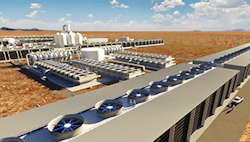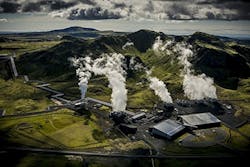Direct Air Capture Technologies Ramp Up Capacity
Extracting industrial quantities of CO2 from the atmosphere using direct air capture (DAC) technologies is a step closer in the United States following a licensing agreement signed between 1PointFive, Houston, and Carbon Engineering, Squamish, B.C.
1PointFive — a development company formed by Oxy Low Carbon Ventures, LLC, a subsidiary of Occidental, and Rusheen Capital Management — will finance and deploy Carbon Engineering’s DAC technology.
This continuous process captures CO2 from the air and delivers it as a purified, compressed gas — using only air, water and energy as inputs.
Consisting of four major pieces of equipment, the process starts with an air contactor modelled on industrial cooling towers. A fan pulls air into this structure, where it passes over thin plastic surfaces that have potassium hydroxide solution flowing over them. This chemically binds with the CO2 molecules, removing them from the air and trapping them in liquid solution as a carbonate salt.
The CO2 contained in this carbonate solution is then put through a series of chemical processes to increase its concentration, purify it, and compress it for delivery in gas form, ready for use or storage.
A pellet reactor separates the salt from the solution to form small pellets. In the third step, a calciner heats the pellets to release the CO2 in pure gas form. Also in this step, a slaker hydrates the processed pellets and recycles them back into the system to reproduce the original capture chemical.
The new facility will be located in the Permian Basin area of the United States on approximately 100 acres. Carbon Engineering, Oxy Low Carbon Ventures, and its contractors have completed more than 25,000 hours of design and development work so far.
The final front-end engineering design for the facility is slated to begin in the first quarter of 2021 with construction to start in 2022 (Figure 1).
Occident will permanently and securely store the CO2 captured at the facility deep underground in geological formations. The company has over 40 years of experience storing CO2, sequestering nearly 20 million mt/y from its operations.
Meanwhile, Climeworks, Zurich, Switzerland, has signed an agreement with carbon storage specialist Carbfix, Reykjavik, Iceland, and Icelandic geothermal energy provider ON Power to lay the foundation for a new DAC plant that will significantly scale-up carbon removal and storage in Iceland.
Under the agreement, Climeworks will use its DAC technology to capture 4,000 mt/y CO₂ from the air at ON Power’s Hellisheidi geothermal facility.
Powered by renewable energy from the facility, the DAC technology involves a two-step process. First, air is drawn into modular CO₂ collectors. The CO₂ is then captured by adsorption on the surface of a highly selective filter material that sits inside the collectors.
Figure 2. The Hellisheidi geothermal power plant. Source: Arni Saeberg.
Second, after the filter material is saturated with carbon dioxide, the collector is closed. The temperature inside the collector rises to between 80°C and 100°C, which releases the carbon dioxide at a purity of over 99%.
The gas is then cooled to 45°C and collected. Each individual CO₂ collector can capture approximately 50 mt/y of the gas.
The modular collectors, powered solely by renewable energy or energy from waste, can be stacked to build machines of any size, says the company. Grey emissions are below 10%, meaning that out of 100 mt of CO₂ captured from the air, at least 90 mt are permanently removed with only up to 10 mt re-emitted.
Carbfix will then use its technology to mix the carbon dioxide with water and pump it deep underground. Through natural mineralization, the carbon dioxide reacts with basalt rock and turns into stone within a few years.
Climeworks and Carbfix currently plan to expand DAC applications by further developing their technologies to the mineralization of atmospheric CO₂.
Figure 3. Celbicon processing lines dedicated to CO2 capture and recycling. Source: Celbicon.
However, mineralization is not the only application open to Climeworks; the company is involved in three other research projects in which it uses CO2 to produce renewable, carbon-neutral fuels and materials.
One, known as Celbicon (cost-effective CO2 conversion into chemicals via combination of capture, electrochemical and biochemical conversion technologies), aims to develop new low-cost, small-scale, robust CO2-to-chemicals technologies that operate at moderate temperatures with high efficiency/yield and low maintenance costs (Figure 3). The European Union-funded project involves 12 other research organizations and chemical companies.
Seán Ottewell is Chemical Processing's editor at large. You can email him at [email protected].



